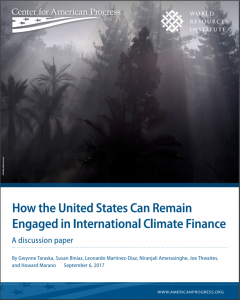Full Title: How the United States Can Remain Engaged in International Climate Finance
Author(s): Gwynne Taraska, Susan Biniaz, Leonardo Martinez-Diaz, Niranjali Amerasinghe, Joe Thwaites, and Howard Maran
Publisher(s): Center for American Progress
Publication Date: September 1, 2017
Full Text: Download Resource
Description (excerpt):
International climate finance is a primary means for the United States to support the global fight against climate change. Finance for climate preparedness helps the most vulnerable developing countries manage climate-induced risks to human health, food security, and regional stability. Meanwhile, finance for clean energy can help prevent further climate change and the associated damage around the globe. Investment in low-carbon and climate-resilient development is therefore persuasive from the perspectives of both humanitarianism and self-interest.
For these reasons, the United States has a bipartisan history of financially supporting international climate efforts. During the George W. Bush administration, for example, the United States pledged $2 billion to the Climate Investment Funds (CIFs), a set of multilateral funds that support clean energy and climate preparedness projects in developing countries.3The United States met that pledge in full, with the final installment delivered in 2016.
Under former President Barack Obama, the United States pledged $3 billion to the Green Climate Fund (GCF), a multilateral fund that provides grants, loans, and equity financing for projects that reduce greenhouse gas emissions and promote climate adaptation, particularly in the poorest and most vulnerable countries. The GCF has approved $2.2 billion for 43 projects since the fund became operational in 2015—from renewable energy in the Pacific islands to flood early-warning systems in Malawi—and has many more projects in the pipeline.5 More than 40 countries have collectively pledged more than $10 billion to the fund to date
